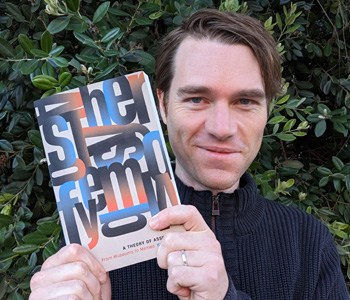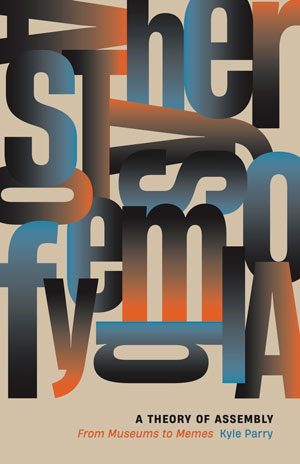
How have new technologies transformed the way we communicate? It’s a question we have to ask in the age of smartphones and the internet and as ever more disruptive expressive tools enter our lives.
One ready-at-hand answer is a play on the old NASA mantra: digital and social media have made cultural exchange faster and cheaper. These new technologies might have even helped make communication better in some respects—more inclusive, enjoyable, effective—although it’s also become clear, between deep fakes, trolling, rampant data collection, e-waste dumps, and all manner of other contemporary horrors, that there’s at least as much bad out there as good.
Another answer to the how-has-it-all-changed question is more involved. Yes, the era of posts and likes and comments is an era of glut and speed, but it’s also—speaking from a US perspective—an era of remarkable, and remarkably fraught, cultural invention. Our feeds and “For You” pages are stages for ideas and interactions we’d never quite imagined; they also hook us into ever more elaborate forms of extraction. Impassioned innovation with these new tools has made possible movements like Black Lives Matter. Radical uses of new media have also coincided with intensification in opposite directions: memes, hashtags, and other novel media forms amplifying causes of hate and regression.
A Theory of Assembly takes this second way of looking at the changes over the last several decades of (mostly US) digital art and culture and turns it up to eleven. Let’s not just focus on so-called “high” or “low” culture; let’s think across all registers. Let’s not just look at one or two but as many mediums and genres as we can. Let’s not just stick with the concepts we’ve inherited; let’s be willing to invent new ones. Let’s not only focus on what seems positive and progressive; let’s consider the whole big mess of possibilities.
The argument that comes out of this research is surprising. We know that a huge amount of digital culture involves that quintessentially human desire to share a story: to trace characters through events. But there’s an extraordinary amount that doesn’t. This book is obsessed with giving these non-narrative versions of electronic expression their due, and it zeroes in on one astonishingly variable example: assembly.
Assembly is active in all kinds of places, from satirical lists to social movement hashtags to the entire history of internet memes. The thing that unites these heterogeneous and not always positive instances of assembly is an emphasis on expressive relationships. When you assemble, you put different media elements together—words, data, sounds, images, objects, even humans and nonhumans—and you do so in a way that registers as meaningful: a disturbing comparison, a provocative combination, a humorous collection, an overwhelming accumulation. Somehow, it’s the arrangement itself that does the talking.
With chapters on art, memes, disaster, and slow and structural violence, the book argues that some of the most pressing questions of our “moment,” including the best and worst of how social media have transformed politics, can’t be properly answered without addressing the workings and implications of this fundamentally relational cultural form.
There are a bunch of really good books that take up the “What’s changed?” question at a big scale. When I first started working on this project, I didn’t think that was what I was doing. I thought I was exploring how digital archives can help us respond to disasters in novel and helpful ways.
The turning point came in 2019. I was teaching an introductory course on digital visual culture that I thought of as a Trojan Horse: get students in the door with the promise of memes and leave them with a whole new armature for critical and humanistic thinking. This time I taught the course, however, something new was in the air. When I would put memes and other digital ephemera on the big screen, the auditorium would fill with absurdly loud laughter. Students’ attempts to explain their attachments to this stuff defied their vocabulary and my own, even the vocabulary in the insightful texts we read. Meanwhile, the world of rapid and often perilous digital expression continued to grow and change outside the classroom walls.
This experience with this great group of students gave me the courage to adopt a much wider optic. I had published an article on the ways artists and citizens alike responded to Hurricane Katrina with highly creative uses of compilation and configuration. I had considered everything from a viral juxtaposition to a Kara Walker installation to a participatory online memory bank, and I had drawn some initial connections with that long-established form of assembly, popular gathering. I went into that summer asking myself what it might mean to apply my most adventurous ideas about cultural forms to any digital context whatsoever, even to art and culture before the digital.
A Theory of Assembly is the fruit of these explorations. The book starts by laying out what I mean by assembly: it’s both a type of thing and something people do, often individually but also often in very distributed fashion, as with the recent (watch as I age this interview!) Barbenheimer meme. The book then examines the powers and perils of assembly across various aesthetic, activist, everyday, and journalistic spheres.
Rather than work through case studies, as is (understandably) common in the humanities, I trace patterns of form and effect across a purposely large and even unwieldy mix of examples. I also rely on an eclectic mix of lenses and subfields, from intersectionality and assemblage theory to performativity and science studies. (I see this as part of an internet-specific interpretive practice I dub “plural reading.”)
My questions are both critical and analytical. How can artists and museums best seize on the aesthetic potential in analogy and arrangement? How is assembly different from well-known combinatorial forms like montage and collage? What can “assembly-infused” maps and practices of “memetic drip” contribute to the expressive demands of climate justice? How do certain pernicious uses of digital assembly, especially those that target social justice movements, manage to succeed, and what can be done in turn?
I love the question about what I’d want a “just-browsing” reader to encounter first, because it’s imagining a reader who hasn’t yet gotten into the book’s “story.” They’re just trying to get a feel for what this author has taken the time to gather: the images and ideas, perspectives and preoccupations poured into the book.
I’d pick an assembly: four images that appear together in the color plates (plates 6–9). The one at the top left is a dam spewing white water. The dam is labeled “I am not racist” and the gushing water is labeled “But.” This is a classic instance of an “image meme” that presents a satirical commentary through a simple act of visual-verbal arrangement. It’s also a prime example of an increasingly intuitive genre of internet culture I hazard calling “expressive folksonomy”: a kind of creative annotation of the world by way of cleverly assembled fragments, labels, gestures, and (quite often) visual metaphors.
In the other corners of the two-page spread, you see projects that couldn’t be more different: Hieronymus Bosch’s hallucinatory 15th century work The Garden of Earthly Delights; the border-crossing balloons of Postcommodity’s Repellent Fence; and the irreverent GIFs that make up the pandemic-era project Well Now WTF?
If someone were to land on these pages, they would find themselves in the middle of the book’s driving questions. What happens when we put seemingly impossibly different communicative elements into spatial proximity? What hidden affinities exist across digital and non-digital uses of expressive gathering? For whom can the arts of assembly matter most? In this case, the choices of what to include—the particular “constituents” of this assembly—are not so obvious. Why should an enigmatic triptych share the stage with a pixilated meme? Why should an author be allowed to compare a GIF-laden website with a wind-blown installation? I can imagine some readers feeling skeptical, which is entirely understandable. I can also imagine others doing what assemblies often ask us to do, which is to generate unexpected associations: the imperiled gathering in the Bosch triptych with the denial of gathering in Well Now WTF?; the variations on tension and division across all four images; and plenty of other connections and contrasts I haven’t anticipated.
With over 80 images, the book is filled with these kinds of provocative and, I hope, “generative” assemblies. In browsing the other chapters, you’d find yourself encountering some key facets of what I’m trying to show and do. For instance, you’d encounter the considerable ambivalence of assembly, as when I juxtapose an account that regularly and “memetically” mocks progressive climate policies with the meme-savvy TikTok account of content creators who favor intersectional environmentalism. You’d also see my insistence on thinking across scales and methods, as when a freeze frame of a trans athlete’s Instagram profile gives way to a flow chart from a Facebook patent for a way of assessing and selecting content based on users’ perceived personality characteristics. In the world of this book, its assemblies all the way down.
I often read conclusions to books that explain how something disturbingly relevant happened in the lead-up to publication. This was true in my case.
A few weeks before I received feedback from peer reviewers, January 6th happened. One of the reviewers recommended I make it the focal point of the closing chapter. I was initially hesitant, because it felt too close, and because I didn’t feel like I could muster the nuance such an event requires. But I soon realized just how many of the book’s threads came together that day. I won’t try to summarize my analysis here, but I think we can learn a lot about that event and the dynamics that surround January 6th by using the lens of digital assembly. We can, for instance, see its mixture of physical and expressive gathering, we can confront the way its organizers relied on forms of “memetic” assembly small and large, and we can ask what larger, longer-existing, pernicious assemblies (and, of course, narratives) its participants mobilized and expanded.
Rather than end on that note, though, A Theory of Assembly closes by invoking the words of people who call for what I think of as reparative assembly: ways of gathering and rearranging the world through whatever expressive methods might help support the promise of mutual and equitable thriving. I’m especially fond of Toni Morrison’s call to creatively endure as we strive after radical and restorative change. “We speak, we write, we do language,” Morrison writes. “That is how civilizations heal. I know the world is bruised and bleeding, and though it is important not to ignore its pain, it is also critical to refuse to succumb to its malevolence. Like failure, chaos contains information that can lead to knowledge—even wisdom. Like art.”


Kyle Parry is Associate Professor of History of Art and Visual Culture at the University of California, Santa Cruz. He is coeditor of Ubiquity: Photography’s Multitudes (Leuven, 2021) and author of A Theory of Assembly: From Museums to Memes (Minnesota, 2023), which is featured in his Rorotoko interview. He recently published an article for Decolonizing Data (Routledge, 2023) called “Metadata Is Not Data About Data” and is now developing a new project on generativity.